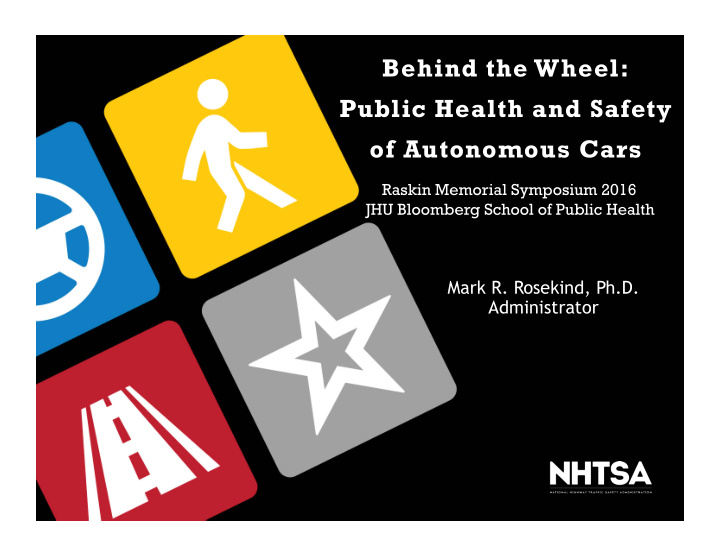



Behind the Wheel: Public Health and Safety of Autonomous Cars Raskin Memorial Symposium 2016 JHU Bloomberg School of Public Health Mark R. Rosekind, Ph.D. Administrator
Transportation: Everywhere, Everyone School Work Commerce Family Food Social Health Athletics Housing Religion Fun Community
NHTSA’s Lifesaving Mission Reduce deaths, injuries and economic losses resulting from motor vehicle crashes
On US Roadways in 2014 . . . • 32,675 lives lost * • 2.3 million injuries • 6.1 million crashes * 95% of all transportation fatalities
On US Roadways in 2014 . . . 94% related to human error/choice
On US Roadways in 2015 . . . Fatalities: 9.3 % estimated increase
Need for Innovation . . . • 25% decrease in fatalities over 10 years: Continue effective strategies! • 2015 estimated increase: Need new tools!!
Technology Saves Lives
Technology Saves Lives 613,501 (1960-2012)
Two Opportunities . . . • Automated Safety Technology • Human Choices Foundation: education/laws/enforcement
11
Safety Technologies AUTOMATIC CRASH NOTIFICATION LANE DEPARTURE WARNING REARVIEW VIDEO SYSTEM (BACKUP CAMERA) FRONTAL PEDESTRIAN IMPACT MITIGATION BRAKING ELECTRONIC STABILITY CONTROL FORWARD COLLISION WARNING VEHICLE-TO-VEHICLE COMMUNICATION (V2V) LANE KEEPING SUPPORT FORWARD COLLISION AVOIDANCE AND MITIGATION
Vehicle to Vehicle (V2V): Connected Automation
Driver Alcohol Detection System for Safety Objective A non-invasive, seamless technology to measure driver BAC and reduce the incidence of drunk driving
DOT/NHTSA Efforts: In Six Months . . . • Develop deployment guidance • Create model state policy • Identify new tools • Structure current tools
Evolution: Transformative Technology • Historically: reduce severity/mitigate injury/medical attention • Proactive safety: avoid the crash
NHTSAadministator@dot.gov
Recommend
More recommend